Abstract
The erythropoietic effect of various thyroid hormones has been studied using erythroid colony formation by canine marrow cells. Although erythropoietin was required for colony growth, physiologic levels of thyroid hormones significantly enhanced colony numbers. The order of potency of the thyroid compounds in their in vitro erythropoietic effect parallels their known calorigenic potency in vivo, suggesting that the in vitro effect is physiologically relevant. A series of studies linked the mechanism of thyroid action to adrenergic receptors on responsive cells. Propranolol, a global β-blocker, inhibited thyroid hormone-responsive erythroid colonies. When adrenergic antagonists having different blocking characteristics were added to culture, the thyroid hormone effect was blocked by those compounds having β2-subspecificity. Velocity sedimentation analysis showed that the peak of colony-forming cells which respond to thyroid hormone and the adrenergic agonist, isoproterenol, sedimented at an identical rate (7.54 mm/h), which is slower than the major peak of colony-forming cells responding to erythropoietin alone (8.62 mm/h). These results demonstrate thyroid hormonal enhancement of in vitro erythroid colony growth which appears mediated by a receptor with β2-adrenergic properties. The data suggest that changes in hormone-target cell interaction may occur during states of abnormal thyroid function.
Full text
PDF
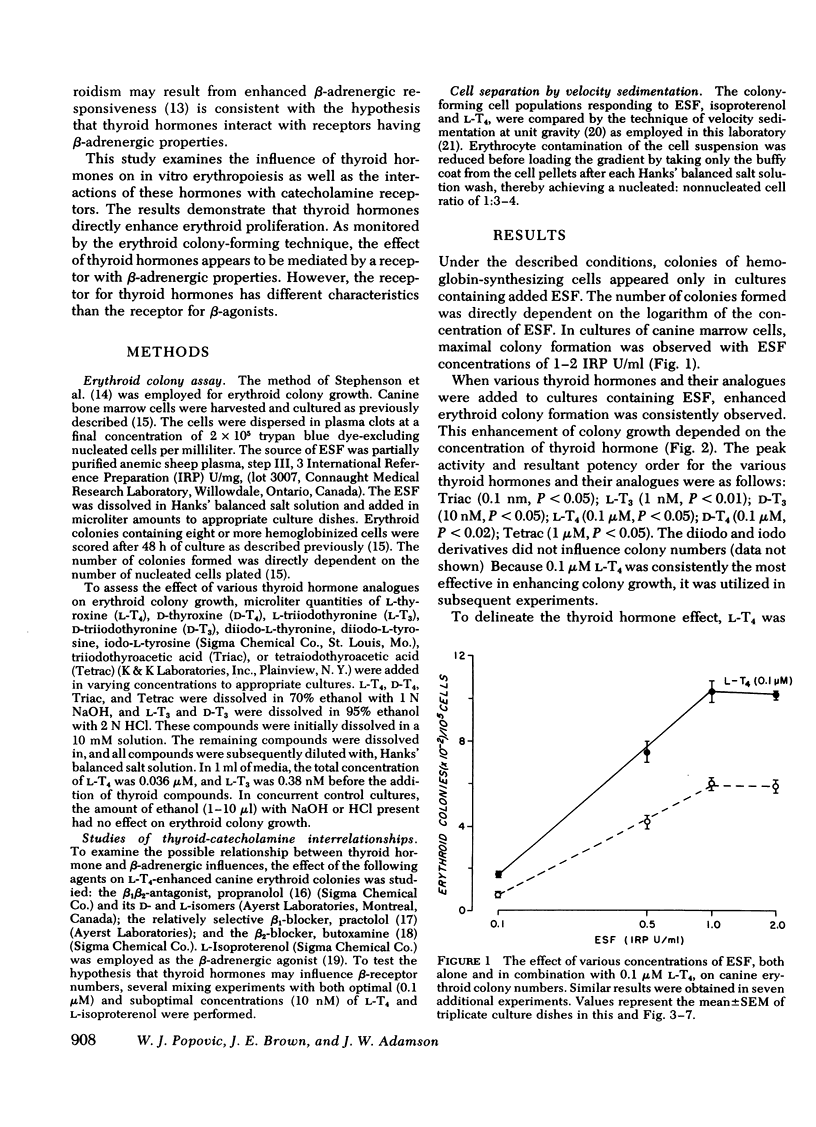
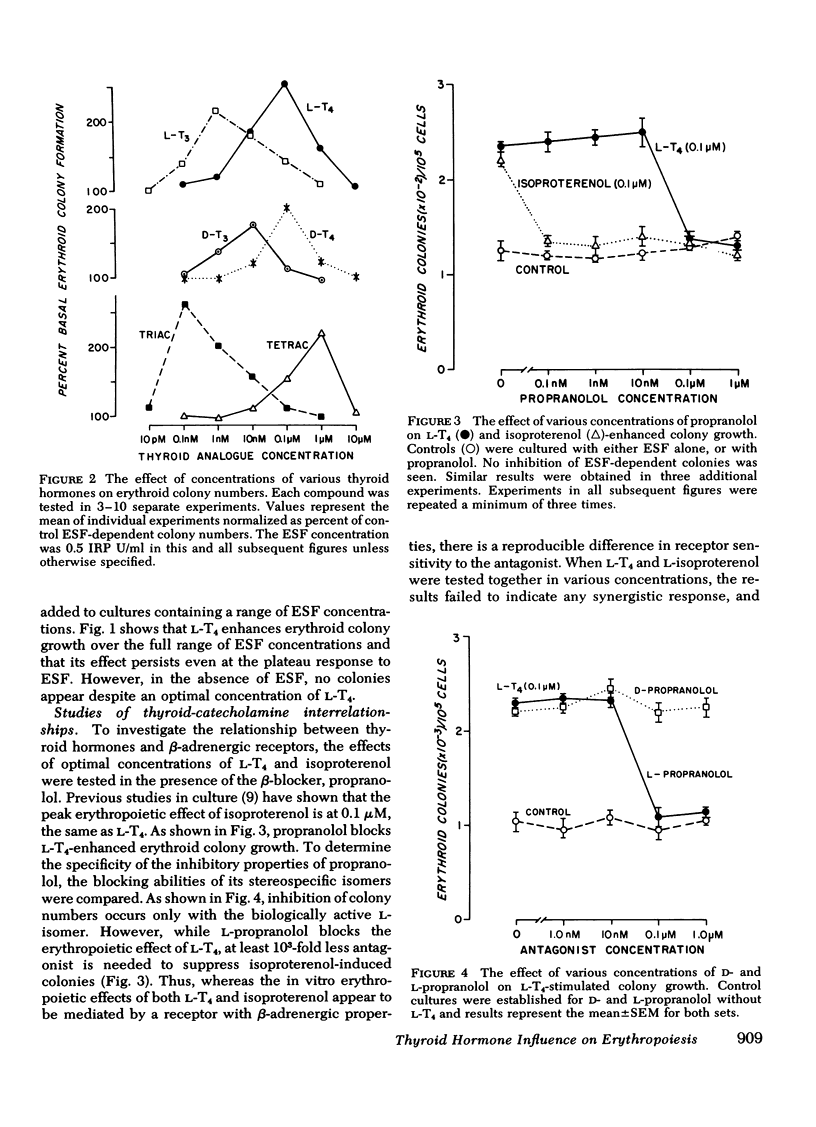
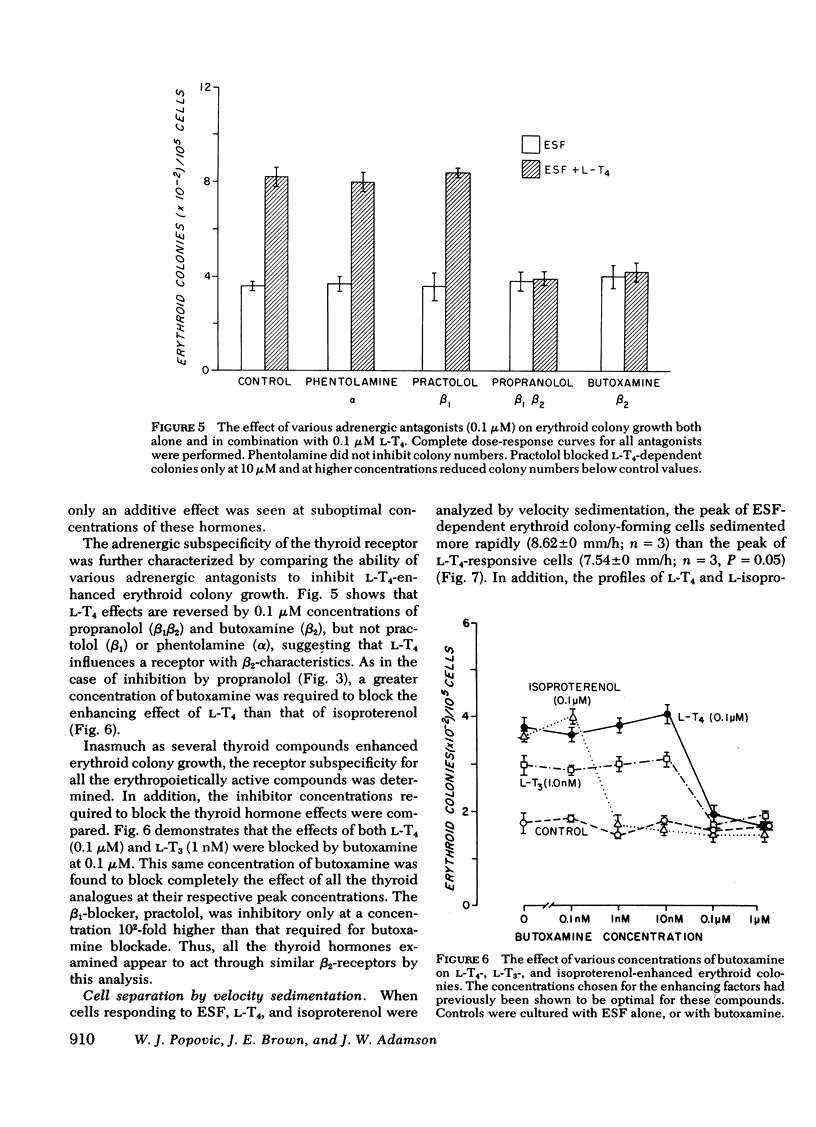
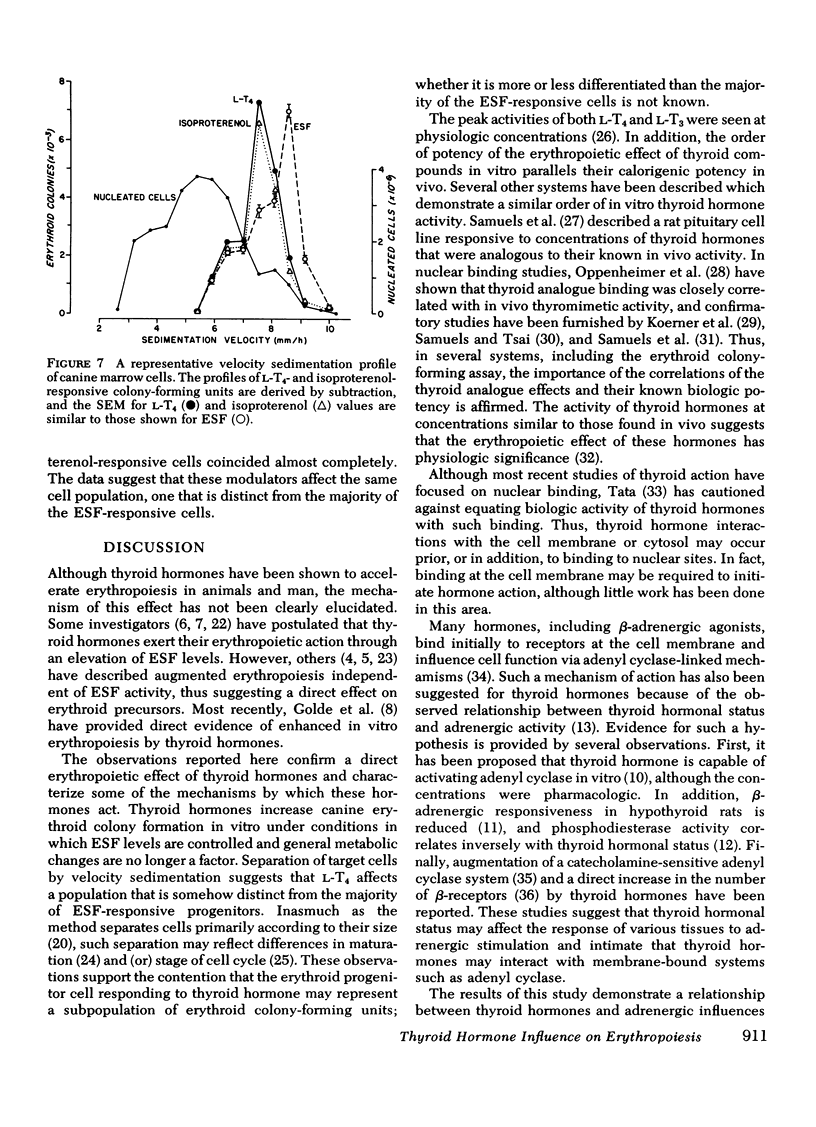
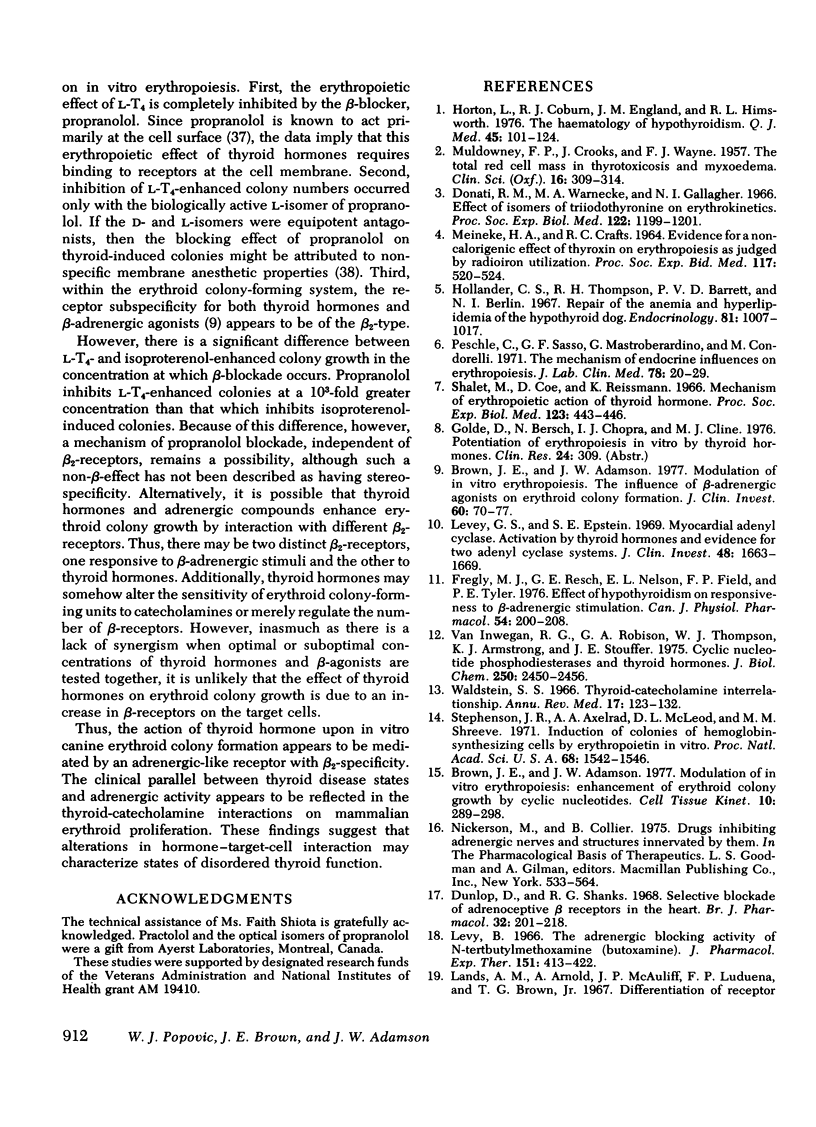
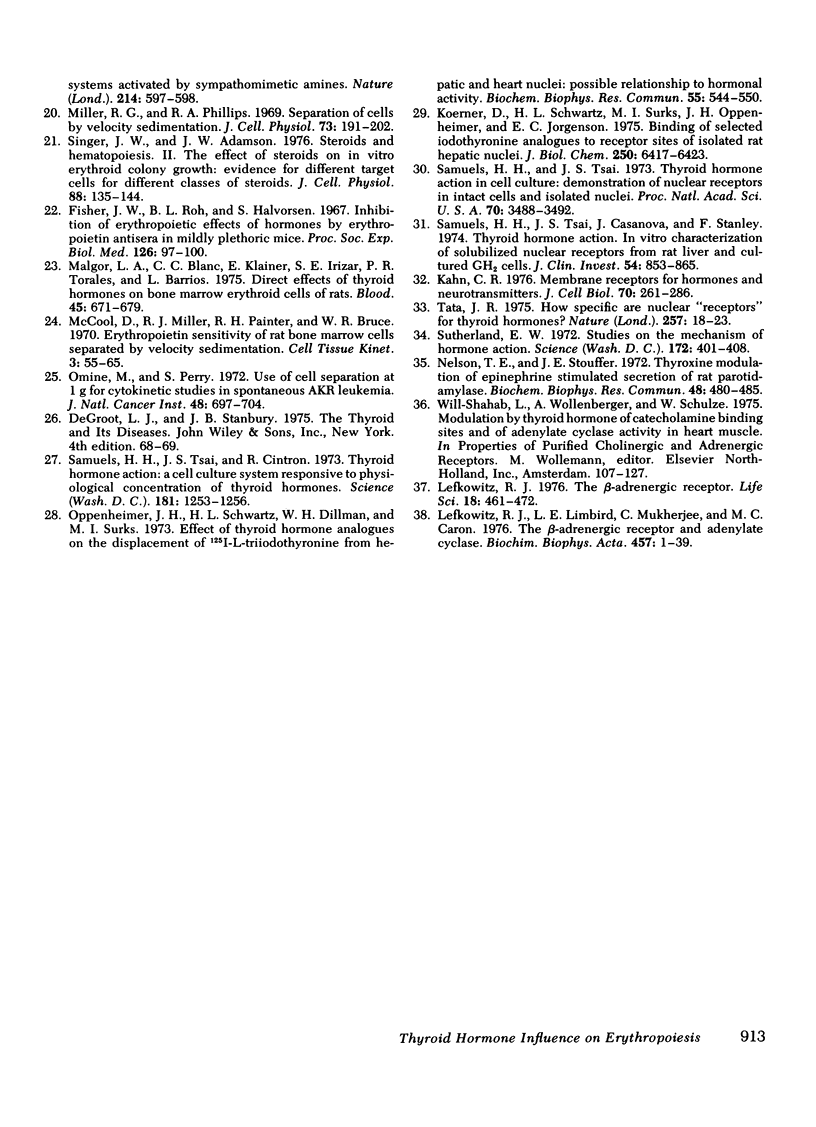
Selected References
These references are in PubMed. This may not be the complete list of references from this article.
- Brown J. E., Adamson J. W. Modulation of in vitro erythropoiesis. The influence of beta-adrenergic agonists on erythroid colony formation. J Clin Invest. 1977 Jul;60(1):70–77. doi: 10.1172/JCI108771. [DOI] [PMC free article] [PubMed] [Google Scholar]
- Brown J. E., Adamson J. W. Modulation of in vitro erythropoiesis: enhancement of erythroid colony growth by cyclic nucleotides. Cell Tissue Kinet. 1977 May;10(3):289–298. doi: 10.1111/j.1365-2184.1977.tb00297.x. [DOI] [PubMed] [Google Scholar]
- Donati R. M., Warnecke M. A., Gallagher N. I. Effect of isomeres of triiodothyronine on erythrokinetics. Proc Soc Exp Biol Med. 1966 Aug-Sep;122(4):1199–1201. doi: 10.3181/00379727-122-31359. [DOI] [PubMed] [Google Scholar]
- Dunlop D., Shanks R. G. Selective blockade of adrenoceptive beta receptors in the heart. Br J Pharmacol Chemother. 1968 Jan;32(1):201–218. doi: 10.1111/j.1476-5381.1968.tb00444.x. [DOI] [PMC free article] [PubMed] [Google Scholar]
- Fisher J. W., Roh B. L., Halvorsen S. Inhibition of erythropoietic effects of hormones by erythropoietin antisera in mildly plethoric mice. Proc Soc Exp Biol Med. 1967 Oct;126(1):97–100. doi: 10.3181/00379727-126-32375. [DOI] [PubMed] [Google Scholar]
- Fregly M. J., Resch G. E., Nelson E. L., Field F. P., Tyler P. E. Effect of hypothyroidism on responsiveness to beta-adrenergic stimulation. Can J Physiol Pharmacol. 1976 Jun;54(3):200–208. doi: 10.1139/y76-032. [DOI] [PubMed] [Google Scholar]
- Hollander C. S., Thompson R. H., Barrett P. V., Berlin N. I. Repair of the anemia and hyperlipidemia of the hypothyroid dog. Endocrinology. 1967 Nov;81(5):1007–1017. doi: 10.1210/endo-81-5-1007. [DOI] [PubMed] [Google Scholar]
- Horton L., Coburn R. J., England J. M., Himsworth R. L. The haematology of hypothyroidism. Q J Med. 1976 Jan;45(177):101–123. [PubMed] [Google Scholar]
- Kahn C. R. Membrane receptors for hormones and neurotransmitters. J Cell Biol. 1976 Aug;70(2 Pt 1):261–286. doi: 10.1083/jcb.70.2.261. [DOI] [PMC free article] [PubMed] [Google Scholar]
- Koerner D., Schwartz H. L., Surks M. I., Oppenheimer J. H. Binding of selected iodothyronine analogues to receptor sites of isolated rat hepatic nuclei. High correlation between structural requirements for nuclear binding and biological activity. J Biol Chem. 1975 Aug 25;250(16):6417–6423. [PubMed] [Google Scholar]
- Lefkowitz R. J., Limbird L. E., Mukherjee C., Caron M. G. The beta-adrenergic receptor and adenylate cyclase. Biochim Biophys Acta. 1976 Apr 13;457(1):1–39. doi: 10.1016/0304-4157(76)90012-5. [DOI] [PubMed] [Google Scholar]
- Lefkowitz R. J. The beta-adrenergic receptor. Life Sci. 1976 Mar 1;18(5):461–472. doi: 10.1016/0024-3205(76)90323-4. [DOI] [PubMed] [Google Scholar]
- Levey G. S., Epstein S. E. Myocardial adenyl cyclase: activation by thyroid hormones and evidence for two adenyl cyclase systems. J Clin Invest. 1969 Sep;48(9):1663–1669. doi: 10.1172/JCI106131. [DOI] [PMC free article] [PubMed] [Google Scholar]
- Levy B. The adrenergic blocking activity of N-tert.-butylmethoxamine (butoxamine). J Pharmacol Exp Ther. 1966 Mar;151(3):413–422. [PubMed] [Google Scholar]
- MEINEKE H. A., CRAFTS R. C. EVIDENCE FOR A NON-CALORIGENIC EFFECT OF THYROXIN ON ERYTHROPOIESIS AS JUDGED BY RADIOIRON UTILIZATION. Proc Soc Exp Biol Med. 1964 Nov;117:520–524. doi: 10.3181/00379727-117-29626. [DOI] [PubMed] [Google Scholar]
- MULDOWNEY F. P., CROOKS J., WAYNE E. J. The total red cell mass in thyrotoxicosis and myxoedema. Clin Sci. 1957 May;16(2):309–314. [PubMed] [Google Scholar]
- Malgor L. A., Blanc C. C., Klainer E., Irizar S. E., Torales P. R., Barrios L. Direct effects of thyroid hormones on bone marrow erythroid cells of rats. Blood. 1975 May;45(5):671–679. [PubMed] [Google Scholar]
- McCool D., Miller R. J., Painter R. H., Bruce W. R. Erythropoietin sensitivity of rat bone marrow cells separated by velocity sedimentation. Cell Tissue Kinet. 1970 Jan;3(1):55–65. doi: 10.1111/j.1365-2184.1970.tb00252.x. [DOI] [PubMed] [Google Scholar]
- Miller R. G., Phillips R. A. Separation of cells by velocity sedimentation. J Cell Physiol. 1969 Jun;73(3):191–201. doi: 10.1002/jcp.1040730305. [DOI] [PubMed] [Google Scholar]
- Nelson T. E., Stouffer J. E. Thyroxine modulation of epinephrine stimulated secretion of rat parotid -amylase. Biochem Biophys Res Commun. 1972 Aug 7;48(3):480–485. doi: 10.1016/0006-291x(72)90372-5. [DOI] [PubMed] [Google Scholar]
- Omine M., Perry S. Use of cell separation at 1 g for cytokinetic studies in spontaneous AKR leukemia. J Natl Cancer Inst. 1972 Mar;48(3):697–704. [PubMed] [Google Scholar]
- Oppenheimer J. H., Schwartz H. L., Dillman W., Surks M. I. Effect of thyroid hormone analogues on the displacement of 125I-L-triiodothyronine from hepatic and heart nuclei in vivo: possible relationship to hormonal activity. Biochem Biophys Res Commun. 1973 Dec 10;55(3):544–550. doi: 10.1016/0006-291x(73)91177-7. [DOI] [PubMed] [Google Scholar]
- Peschle C., Sasso G. F., Mastroberardino G., Condorelli M. The mechanism of endocrine influences on erythropoiesis. J Lab Clin Med. 1971 Jul;78(1):20–29. [PubMed] [Google Scholar]
- Samuels H. H., Tsai J. S., Casanova J., Stanley F. Thyroid hormone action: in vitro characterization of solubilized nuclear receptors from rat liver and cultured GH1 cells. J Clin Invest. 1974 Oct;54(4):853–865. doi: 10.1172/JCI107825. [DOI] [PMC free article] [PubMed] [Google Scholar]
- Samuels H. H., Tsai J. S., Cintron R. Thyroid hormone action: a cell-culture system responsive to physiological concentrations of thyroid hormones. Science. 1973 Sep 28;181(4106):1253–1256. doi: 10.1126/science.181.4106.1253. [DOI] [PubMed] [Google Scholar]
- Samuels H. H., Tsai J. S. Thyroid hormone action in cell culture: domonstration of nuclear receptors in intact cells and isolated nuclei. Proc Natl Acad Sci U S A. 1973 Dec;70(12):3488–3492. doi: 10.1073/pnas.70.12.3488. [DOI] [PMC free article] [PubMed] [Google Scholar]
- Shalet M., Coe D., Reissmann K. R. Mechanism of erythropoietic action of thyroid hormone. Proc Soc Exp Biol Med. 1966 Nov;123(2):443–446. doi: 10.3181/00379727-123-31509. [DOI] [PubMed] [Google Scholar]
- Singer J. W., Adamson J. W. Steroids and hematopoiesis. II. The effect of steroids on in vitro erythroid colony growth: evidence for different target cells for different classes of steroids. J Cell Physiol. 1976 Jun;88(2):135–143. doi: 10.1002/jcp.1040880203. [DOI] [PubMed] [Google Scholar]
- Stephenson J. R., Axelrad A. A., McLeod D. L., Shreeve M. M. Induction of colonies of hemoglobin-synthesizing cells by erythropoietin in vitro. Proc Natl Acad Sci U S A. 1971 Jul;68(7):1542–1546. doi: 10.1073/pnas.68.7.1542. [DOI] [PMC free article] [PubMed] [Google Scholar]
- Sutherland E. W. Studies on the mechanism of hormone action. Science. 1972 Aug 4;177(4047):401–408. doi: 10.1126/science.177.4047.401. [DOI] [PubMed] [Google Scholar]
- Tata J. R. How specific are nuclear "receptors" for thyroid hormones? Nature. 1975 Sep 4;257(5521):18–23. doi: 10.1038/257018a0. [DOI] [PubMed] [Google Scholar]
- Van Inwegen R. G., Robison G. A., Thompson W. J. Cyclic nucleotide phosphodiesterases and thyroid hormones. J Biol Chem. 1975 Apr 10;250(7):2452–2456. [PubMed] [Google Scholar]
- Waldstein S. S. Thyroid-catecholamine interrelations. Annu Rev Med. 1966;17:123–132. doi: 10.1146/annurev.me.17.020166.001011. [DOI] [PubMed] [Google Scholar]


